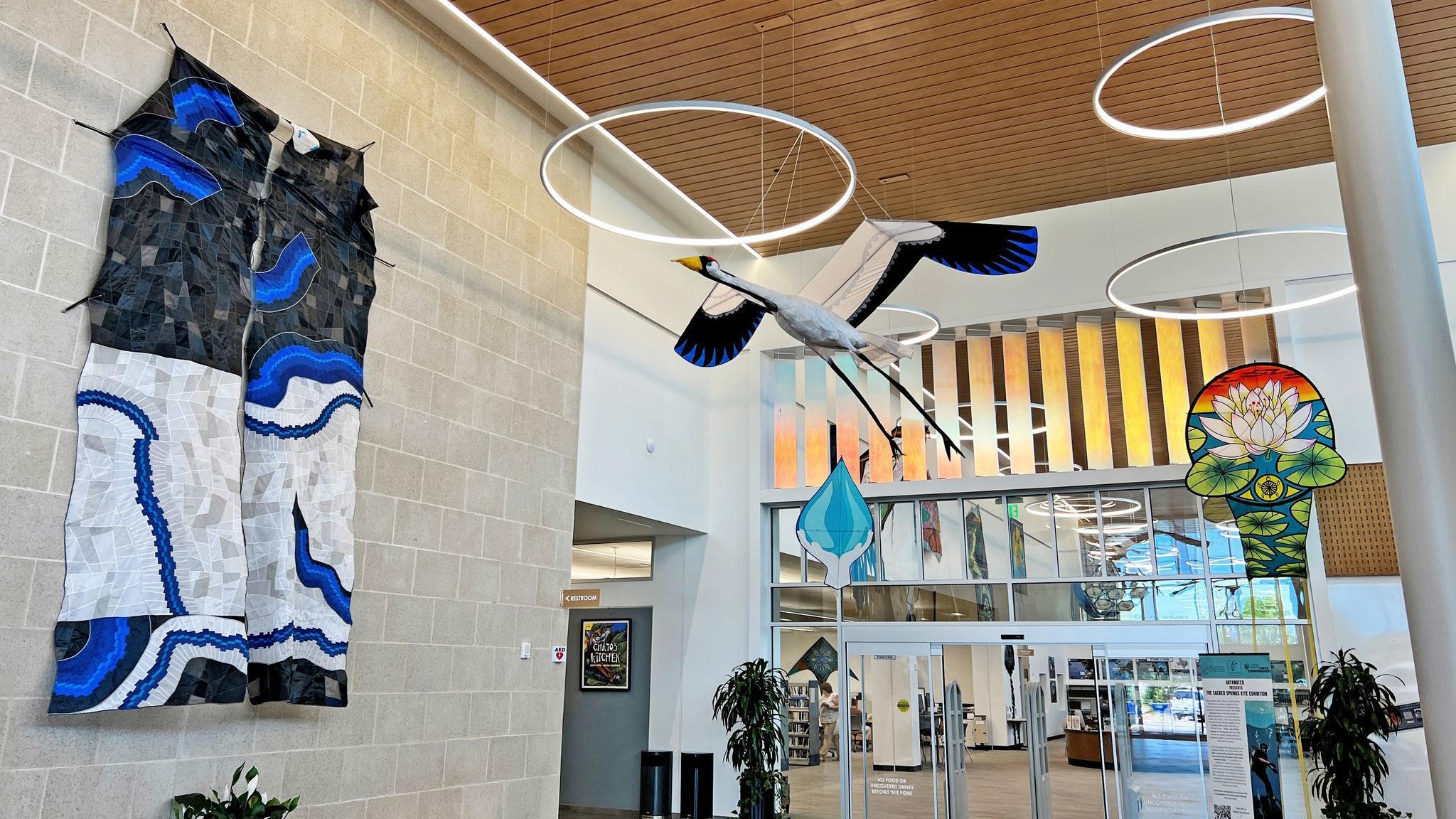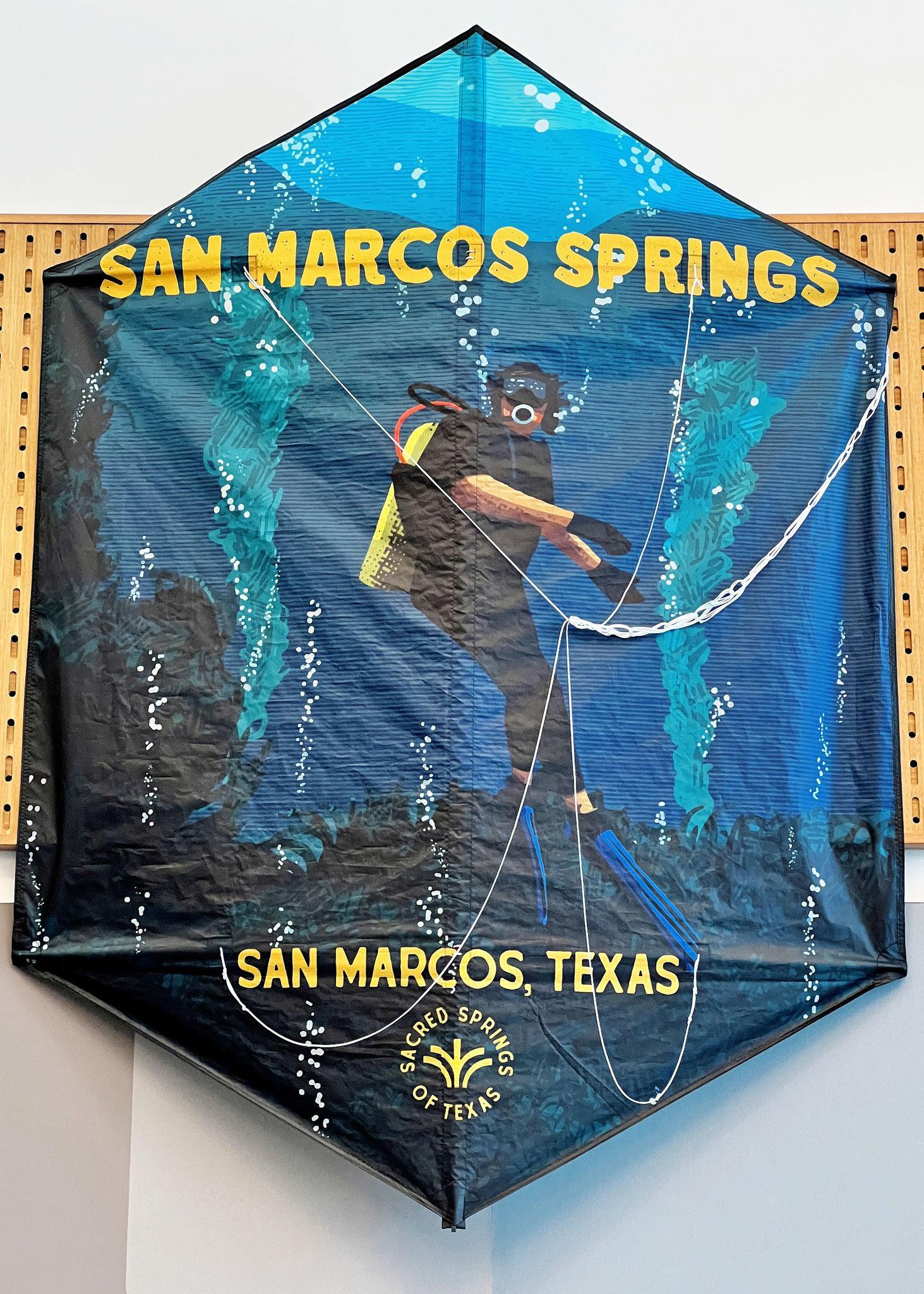
The Sacred Springs Kite Exhibition will be on display at the San Marcos Public Library until Sept. 30. The kites will be unveiled at a ceremony at 6 p.m. and ending at 9 p.m. The exhibition will show the work of multiple San Marcos artists and highlight the springs of Central Texas.
Photo provided by the city of San Marcos

The kite highlighting the San Marcos Springs is on display. The kite was designed by John Mata and was fabricated by Drake Smith.
Photo provided by the city of San Marcos
Sacred Springs Kite Exhibition comes to the library
Being a river town and a community that prides itself on keeping the San Marcos and Blanco rivers clean, of interest to many San Martians will be the temporary art exhibit created with water conservation in mind.
The Sacred Springs Kite Exhibition is at the San Marcos Public Library from 6 p.m. to 9 p.m. today. The kites will be displayed in San Marcos until Sept. 30 and reside here due to a partnership between the San Marcos Arts Commission and the Wimberley Valley Watershed Association. After opening night, the exhibition can be viewed at these locations during business hours: The San Marcos Public Library located at 625 E. Hopkins Street, the San Marcos Activity Center located at 501 E. Hopkins Street and The Meadows Center for Water and the Environment located at 211 San Marcos Springs Drive. The exhibition includes 50 kites created by local and national artists.
The kites are a natural fit for display in San Marcos. “Our chair, Jamey Poole, saw the exhibit in Austin last year and asked the rest of the Arts Commission if this was something they wanted to bring to our community. The answer was a resounding ‘Yes!’ We coordinated with the Watershed Association on the logistics, funding and placement of the kites. It was a natural fit for us, since the headwaters of the San Marcos River are right here in town,” San Marcos Arts Commission Coordinator Trey Hatt said.
San Marcos artists have contributed to this exhibit as well. “In addition to bringing existing kites from the exhibition to San Marcos, we commissioned four new art kites by local artists Darin Wood, Lisa McPike Smith, Michelle Esguerra Wilson, and Dayann Pazmino. Other local artists already had pieces in the exhibit: Rene Perez, Topher Sipes, and Veronica Mestre,” Hatt said.
The Wimberley Watershed Association collaborated with a seasoned curator to bring the exhibit to life. “We partnered with Terry Zee Lee, and Terry is an amazing kite curator. She’s been curating incredible exhibits all over the country for many, many years and using kites as a way to teach themes of not just the STEM topics but she’s also adding art into that. We partnered with her last year to create this kite exhibition that relied on over 50 art types that were created from over 30 local and national artists,” Director of Creative Strategy and Program Implementation for the Wimberley Valley Watershed Association Aliya Rose said. “The call was just asking people to create something that would fly high in the sky that was inspired by water,” adding that the kites in the exhibit range from 2 feet to 12 feet long.
The water in this area is valuable to the community in a variety of ways. “Clean water is of course, not only important for the environment and all the inhabitants of the natural ecosystems that surround us, but it’s a public health issue. We absolutely need it to survive and to thrive for not just us but future generations,” Rose said. 'Specifically to the Hill Country, beyond our health and wellness, any given watershed has incredible economic benefits too. We have so many visitors to Jacob’s Well, Blue Hole and San Marcos Springs. For Jacob’s Well and the Blue Hole we have about 100,000 people that come swimming there every year and probably about a million people that come just to visit, which is about $80 million to $100 million locally. Around 80% of sales tax comes from tourism. With those places being closed this year we’re going to take a really big economic hit.”
This project arose from the Wimberley Valley Watershed Association’s Art4Water program which is meant to promote ecological sustainability and environmental protection through art. “Art4Water is one of the Watershed’s experiential programs. We’ve been around for about 30 years protecting water in the Hill Country, but Art4Water was just founded last year. It really aims to bridge the gap between culture and conservation,” Rose said. “We really looked at artists as the traditional storytellers and translators of complicated concepts that might be limited by the spoken word. Since we’re at this really unique moment in human and environmental history, a moment that really requires our collaboration to rise above the degradation that’s happening in our environment and in our communities, it was really just born out of a desire to speak to the masses and to create an environment where people have a felt sense of what is going on,” According to the Watershed Association’s website, the exhibition highlights eight of Texas’ most unique springs, which deepen the human connection to the environment and inspire stewardship for thousands who come to marvel at these springs each year. Springs birth the beautiful rivers that this community spends so much time in; they mirror the health of our most valuable aquifers and they provide a vital connection to nature.
The Watershed Association website states that Sacred Springs gives a nod to the reverence given to the springs by indigenous people and a mystical connection with this source of life. The eight sacred springs commemorated in the exhibit are near and dear to local’s hearts and include San Solomon, Comanche, the Blue Hole, Comal, San Marcos, Barton, Krause and Jacob’s Well.
“Right now we’re in an extreme drought. Western Hays County has never seen a drought this extreme actually in recorded history. I think people see that we get these little light rains and assume that we’re back to normal, and in reality we’re still about 18 inches behind where we’ve been in the past for this year. Only about 3% to 5% of the rain that comes down replenishes the aquifer, so we would need a lot more water to come down in order to replenish what it is that we’re missing,” Rose said.
To learn more about the exhibit go to visitsanmarcos. com/artkites.











